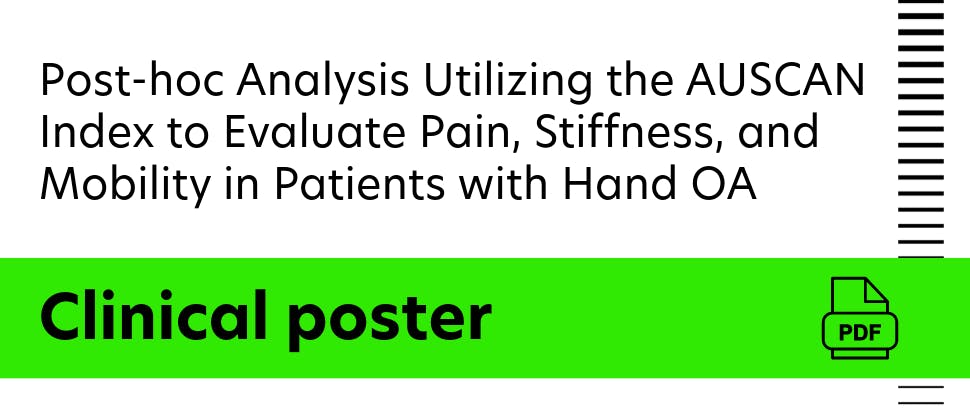Clinical Poster, Hand OA

Study Objective
The purpose of this post-hoc analysis was to evaluate the scores from the individual AUSCAN questions from an 8-week randomized, double-blind, placebo-controlled trial of diclofenac sodium 1% gel (DSG) vs vehicle in the treatment of hand OA.
Methodology
Patients diagnosed with hand OA in the dominant hand were randomly assigned DSG (n = 198) or vehicle (n = 187) and applied 2 g to each hand 4 times daily for 8 weeks. Vehicle was identical to DSG except for the absence of diclofenac sodium. AUSCAN questions were scored using a scale of 0 (no pain/stiffness/difficulty)-100 (extreme pain/stiffness/difficulty) at baseline and at weeks 1, 2, 4, 6 and 8. Mean scores for each question were assessed and compared between treatments at each timepoint using Analysis of Covariance (ANCOVA) with baseline as a covariate in the model and with no multiplicity correction.
Results
- DSG demonstrated efficacy with reduction of pain subscale question scores at week 6 by 42%-44% (33%-35% for vehicle), stiffness scores by 42% (30% for vehicle) and physical function subscale scores by 39%-45% (27%-33% for vehicle).
- Statistically significant differences favoring DSG over vehicle were observed at weeks 4 and 6 (the primary endpoints) in all categories and at week 8 in the stiffness and physical function questions.
- The questions with the greatest separation from vehicle at week 6 involved pain when turning and squeezing objects, stiffness upon wakening, difficulty turning doorknobs and faucets, and difficulty getting dressed, all of which are important components of hand functionality in daily living.
Download the clinical poster below to learn more.


Order Samples
Request Haleon product samples, which are subject to eligibility requirements and availability.

Join Haleon HealthPartner
Get access to professional and patient resources, scientific research, and free patient samples.